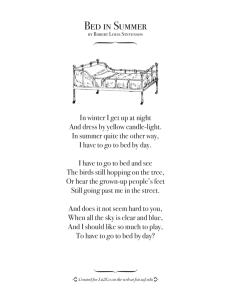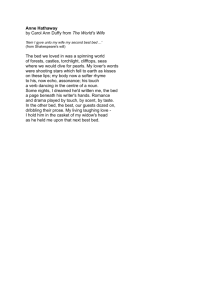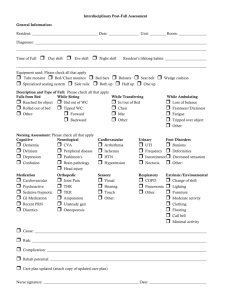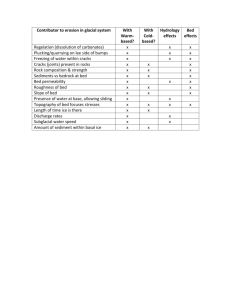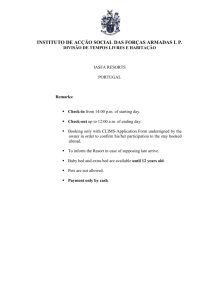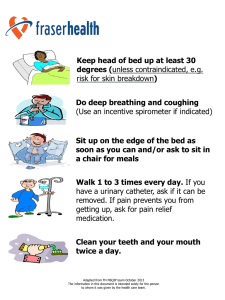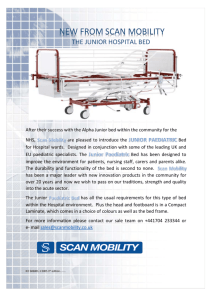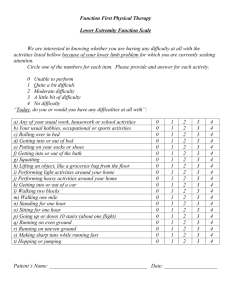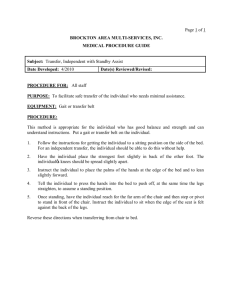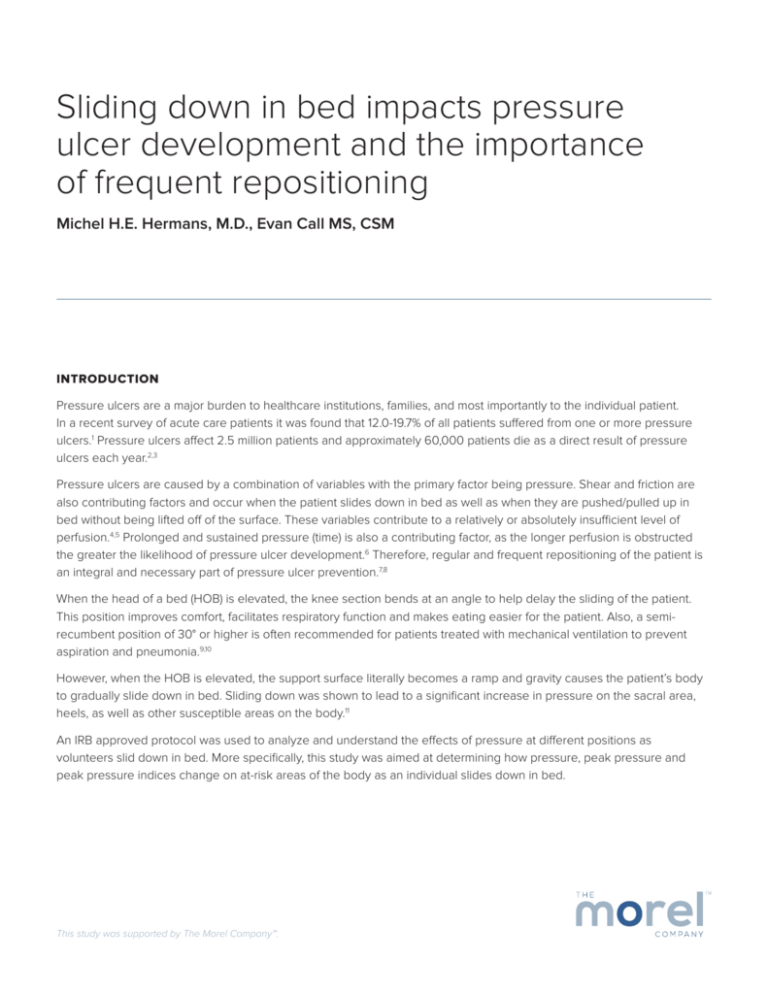
Sliding down in bed impacts pressure
ulcer development and the importance
of frequent repositioning
Michel H.E. Hermans, M.D., Evan Call MS, CSM
INTRODUCTION
Pressure ulcers are a major burden to healthcare institutions, families, and most importantly to the individual patient.
In a recent survey of acute care patients it was found that 12.0-19.7% of all patients suffered from one or more pressure
ulcers.1 Pressure ulcers affect 2.5 million patients and approximately 60,000 patients die as a direct result of pressure
ulcers each year.2,3
Pressure ulcers are caused by a combination of variables with the primary factor being pressure. Shear and friction are
also contributing factors and occur when the patient slides down in bed as well as when they are pushed/pulled up in
bed without being lifted off of the surface. These variables contribute to a relatively or absolutely insufficient level of
perfusion.4,5 Prolonged and sustained pressure (time) is also a contributing factor, as the longer perfusion is obstructed
the greater the likelihood of pressure ulcer development.6 Therefore, regular and frequent repositioning of the patient is
an integral and necessary part of pressure ulcer prevention.7,8
When the head of a bed (HOB) is elevated, the knee section bends at an angle to help delay the sliding of the patient.
This position improves comfort, facilitates respiratory function and makes eating easier for the patient. Also, a semirecumbent position of 30° or higher is often recommended for patients treated with mechanical ventilation to prevent
aspiration and pneumonia.9,10
However, when the HOB is elevated, the support surface literally becomes a ramp and gravity causes the patient’s body
to gradually slide down in bed. Sliding down was shown to lead to a significant increase in pressure on the sacral area,
heels, as well as other susceptible areas on the body.11
An IRB approved protocol was used to analyze and understand the effects of pressure at different positions as
volunteers slid down in bed. More specifically, this study was aimed at determining how pressure, peak pressure and
peak pressure indices change on at-risk areas of the body as an individual slides down in bed.
This study was supported by The Morel Company™.
METHODS
A descriptive study comparing pressure distribution at different body locations at four discrete positions in bed was
conducted in the lab of Evan Call MS, CSM of Weber State University, using an IRB approved protocol and following
guidelines as set by the company’s standard testing procedures.
The following three types of surfaces were used for all volunteers:
• Powered integrated air surfaceA
• Non-powered air surfaceB
• Viscoelastic memory foam surfaceC
The bed framesD, with each surface, were set with the HOB elevated to 30° and the knee angle at 14° for all
measurement phases.
Four volunteers were used for the testing:
• Female, 145 lbs., 67", BMI 23.4
• Male, 178 lbs., 71.5", BMI 26.3
• Female, 138 lbs., 68.75", BMI 21.6
• Male, 220 lbs., 74", BMI 29.0
A calibrated Xsensor X2 36x84 pressure map was used for the measurements. In this map, each sensor covered
1.25 inch2.
Volunteers were placed on the surfaces and pressure was measured with each volunteer in four discrete positions
as they slid down in bed (0", 3", 6" and 9"). Sliding was accomplished between each distance in a manner consistent
with how a patient would normally slide down in bed. Each volunteer was measured five times for two minutes in
each position with the average of the data being used in the analyses and corresponding Figures.
FIGURE I
Position 1
0" DOWN
Position 2
3" DOWN
Position 3
6" DOWN
0.0 10.0 12.6 15.3 18.0 20.6 23.3 26.0 28.6 31.3 34.0 36.6 39.3 42.0 44.6 47.3 50.0
2
Sliding down in bed impacts pressure ulcer development
and the importance of frequent repositioning
Position 4
9" DOWN
mmHg
A laser level was pointed at a mark on the volunteer’s skin of the lateral iliac crest. The distance between the skin mark
and the laser light was used to measure the distance from the original comfort position where the patient was properly
placed up in bed (0" down).
A number of values were measured or calculated, including:
• Contact Area (CA, cm2): the area with pressure readings greater than or equal to 5 mmHg
The Contact Area was calculated from:
CA = (A x N5) / NTotal where:
A = area pressure mat containing sensors, cm2
N5 = number of sensors with pressure readings > 5 mmHg
NTotal = total number of sensors in mat (or zone)
• Peak Pressure (PP): the highest recorded reading on the pressure map or within a specified zone
• Peak Pressure Index (PPI): the highest recorded average in a given area, measured using an array of four sensors
including the PP
All pressure measurements are expressed in millimeters of mercury (mmHg).
Figures II, III, IV, V and VI show the plotted data lines for the Total Contact Area, Peak Pressure and Peak Pressure Index
averages for all volunteers for each of the three surfaces, as well as the overall average and regression line for each
data set.
RESULTS
TOTAL CONTACT AREA
4600
4400
4200
AREA (cm 2 )
Sliding down in a hospital bed causes weight shifts
to the sacral area, heels and other at-risk areas
of the body (Figure I). This weight shift causes the
volunteer’s Total Contact Area with the surface to
decrease (Figure II). This decrease in Total Contact
Area results in an increase in pressures, peak
pressures and peak pressure indices in both the
sacral area and heels. Basic physics supports this
finding; a given amount of force applied over a small
area will produce greater pressure than the same
amount of force applied over a larger area.
FIGURE II
4000
3800
3600
3400
3200
3000
0"
3"
6"
9"
POSITION DOWN IN BED (INCHES)
non-powered air
viscoelastic memory foam
average
regression
powered integrated air
3
FIGURE III
FIGURE IV
SACRUM PEAK PRESSURE INDEX
41
41
39
39
37
37
mmHg
mmHg
SACRUM PEAK PRESSURE
35
33
35
33
31
31
29
29
27
0"
3"
6"
27
9"
0"
viscoelastic memory foam
average
regression
powered integrated air
viscoelastic memory foam
average
regression
FIGURE VI
43
43
38
38
33
33
mmHg
28
23
23
18
13
13
3"
6"
9"
8
0"
non-powered air
viscoelastic memory foam
average
regression
powered integrated air
Sliding down in bed impacts pressure ulcer development
and the importance of frequent repositioning
3"
6"
9"
POSITION DOWN IN BED (INCHES)
POSITION DOWN IN BED (INCHES)
4
powered integrated air
28
18
0"
9"
HEEL PEAK PRESSURE INDEX
HEEL PEAK PRESSURE
mmHg
non-powered air
FIGURE V
8
6"
POSITION DOWN IN BED (INCHES)
POSITION DOWN IN BED (INCHES)
non-powered air
3"
non-powered air
viscoelastic memory foam
average
regression
powered integrated air
RESULTS (CONTINUED)
Peak pressures and peak pressure indices increase in the sacral area as the volunteer slides down in bed (Figures III and
IV). Additionally, as demonstrated in Figure I, pressures in the sacral area continue to increase as the volunteer slides
further down in bed, and is highlighted by a shift or rotation of the volunteer onto their trochanters the further they slide.
Peak pressures and peak pressure indices show a strong upward trend in the heel area as the volunteer slides down in
bed (Figures V and VI). Also, as demonstrated in Figure I, pressures in the heel area continue to increase as the volunteer
slides further down in bed, and becomes visibly noticeable at the 9" position. This occurs as the volunteer’s feet contact
the footboard causing their knees to bend, which results in a significant weight shift to the heels.
When the volunteer’s feet contacted the footboard, a trend of decreasing pressure and contact area beyond the 9"
position was observed. This suggests a realistic scenario where the patient’s feet encounter the footboard, offloading
pressure from the surface to the footboard, resulting in a higher risk of pressure ulcer development.12
The previous Figures show that Total Contact Area decreased and pressure increased as each volunteer slid down
regardless of the type of surface. The results of this study are significant at a 95% confidence level.
DISCUSSION
Elevation of the head of the bed is often used to provide better overall comfort to patients. However, when the head
of the bed is raised, gravity forces patients to slide down in bed.
This study, as discussed above, results in the following conclusions as the patient slides down in bed:
• Patients’ weight shifts causing their Total Contact Area with the surface to decrease
• A decrease in Total Contact Area results in an increase in pressures, peak pressures and peak pressure indices
in the sacral area and heels
• As the patient’s feet contact the footboard, their knees bend resulting in significant pressure increase
on their heels
• As the patient’s knees bend, their body rotates onto their side, increasing pressure in their trochanter area
• It is highly likely that the above phenomena will contribute to a higher incidence of pressure ulcer development
The study results presented here are consistent with recent literature findings:
• Okuwa13 observed that in some patients in the supine position and with the head of the bed elevated to 30°,
wound margins at the sacrum and coccyx regions were thickened. This study showed that pressure, measured
at thickened skin, was higher than pressure in normal skin in the same patient while the thicker-skinned margins
healed more slowly, leading to the conclusion that a 30° HOB elevation negatively influences healing by
increasing pressure.
• In a study in which transcutaneous oxygen (TcPO2) and transcutaneous carbon dioxide (TcPCO2) levels were
measured, TcPO2 decreased and TcPCO2 increased at the sacral area when the HOB angle was 45° or higher,
indicating compromised tissue viability.14
• Peterson15 showed that raising the head of bed to 30° increases peak interface pressure significantly in a study
with volunteers. The same author stated in a different study that “relieving at-risk tissue is a necessary part of
pressure ulcer prevention, but the repositioning practice itself needs improvement”.8
5
CONCLUSION
While it is commonly accepted that repositioning patients places a heavy burden on nursing staff16, with regard to time
management, as well as from a physical strain and risk for injury, the research study above shows evidence that it can
also have an impact on clinical outcomes.
When gravity causes patients to slide down in bed, pressure increases even at the earliest stages of migration. Pressure
increases accelerate the further the patient slides down in bed. This research demonstrates that sliding down in bed
escalates the pressure ulcer development risk for patients. Therefore, frequent and timely repositioning of patients up
in bed, in whatever form, must be an integral part of any pressure ulcer prevention and management program.
6
Sliding down in bed impacts pressure ulcer development
and the importance of frequent repositioning
REFERENCES
1
Jenkins ML, O’Neal E. Pressure ulcer prevalence and incidence in acute care. Adv Skin Wound Care 2010;23(12):556-9.
2
JCPoP. Strategies for Preventing Pressure Ulcers. Joint Commission Perspectives on Patient Safety, 2008.
3
Berlowitz D, VanDeusen D, Parker P, Niederhauser A, Silver J, Logan C, Ayello E, et al. Preventing Pressure Ulcers in Hospitals. May 2014
ed: Agency for Healthcare Research and Quality 2011.
4
Daniel RK, Priest DL, Wheatley DC. Etiologic factors in pressure sores: an experimental model. Arch Phys Med Rehabil 1981;62(10):492-8.
5
Lahmann NA, Kottner J. Relation between pressure, friction and pressure ulcer categories: a secondary data analysis of hospital patients
using CHAID methods. Int J Nurs Stud 2011;48(12):1487-94.
6
Linder-Ganz E, Engelberg S, Scheinowitz M, Gefen A. Pressure-time cell death threshold for albino rat skeletal muscles as related to
pressure sore biomechanics. J Biomech 2006;39(14):2725-32.
7
Moore Z, Cowman S, Conroy RM. A randomised controlled clinical trial of repositioning, using the 30 degrees tilt, for the prevention of
pressure ulcers. J Clin Nurs 2011;20(17-18):2633-44.
8
Peterson MJ, Gravenstein N, Schwab WK, van Oostrom JH, Caruso LJ. Patient repositioning and pressure ulcer risk--monitoring interface
pressures of at-risk patients. J Rehabil Res Dev 2013;50(4):477-88.
9
Metheny NA, Davis-Jackson J, Stewart BJ. Effectiveness of an aspiration risk-reduction protocol. Nurs Res 2010;59(1):18-25.
10 Efrati S, Deutsch I, Antonelli M, Hockey PM, Rozenblum R, Gurman GM. Ventilator-associated pneumonia: current status and future
recommendations. J Clin Monit Comput 2010;24(2):161-8.
11
Lippoldt J, Pernicka E, Staudinger T. Interface pressure at different degrees of backrest elevation with various types of pressureredistribution surfaces. Am J Crit Care 2014;23(2):119-26.
12 Black JM, Cuddigan JE, Walko MA, Didier LA, Lander MJ, Kelpe MR. Medical device related pressure ulcers in hospitalized patients.
Int Wound J 2010;7(5):358-65.
13 Okuwa M, Sugama J, Sanada H, Konya C, Kitagawa A. Measuring the pressure applied to the skin surrounding pressure ulcers while
patients are nursed in the 30 degree position. J Tissue Viability 2005;15(1):3-8.
14 Chai CY, Bader DL. The physiological response of skin tissues to alternating support pressures in able-bodied subjects. J Mech Behav
Biomed Mater 2013;28:427-35.
15 Peterson MJ, Schwab W, van Oostrom JH, Gravenstein N, Caruso LJ. Effects of turning on skin-bed interface pressures in healthy adults.
J Adv Nurs 2010;66(7):1556-64.
16 Gallagher SM. Pressure ulcers, outcomes, and the nursing shortage. Ostomy Wound Manage 2001;47(8):49-51.
A
VersaCare A.I.R.® Surface, Hill-Rom®
B
Accumax Quantum™ VPC Surface, Hill-Rom®
C
Hercules Dream™ Sleep Surface, The Morel Company™
D
Advance Series® Med Surg Bed, Hill-Rom® and VersaCare® Med Surg Bed, Hill-Rom®
7
WWW. MORELCOMPA N Y.C OM
|
PH ON E 8 5 5 - 9 3 2 - 6 1 0 0
MN - 0018-R EV1
© 2014 The Morel Company, ALL RIGHTS RESERVED

